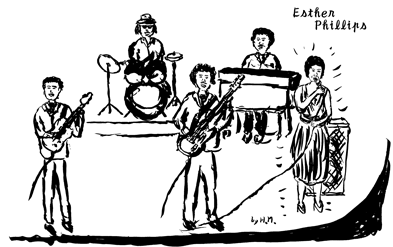

Though it may not be exactly called as 'the charm of crooness', Esther Phillips is a splendid alto singer with an edged voice and a nice vibrato. The box set "Atlantic Rhythm & Blues 1947-1974" contained two songs of hers, each of which tasted unique and hooked on to my memory. Her tune Release Me, a country song backed by a sweet chorus and orchestra of the early 1960s, is so soulful as her voice explodes after it is fueled to the full, and it reminds me of Ray Charles' series of country sides . And then And I Love Him, the cover of famous Beatles' tune, mesmerizes you with her low and steady delivery without raising her voice, while a melodious flute and strings and horns were effectively performed. She rolls and exhausts her own voice and doesn't sing superficially, and it makes me feel comfortable in the way different from gospel. Compared with soul music, which is closely related to gospel and blow your positive side of mind as your spirit is lifted higher, Esther's voice has a shadow drenched with a little more obsolete deep blues. I guess this might have something to do with the fact that she had been a R&B singer since before and after 1950 in her low teens.
Esther Phillips made her debut in 1950 with the name 'Little Esther' and the tune Double Crossing Blues, accompanied with the band of famous Johnny Otis and the duet of Bobby Nunn (the bass vocal of Robins (the future Coasters), and suddenly won fame(this original recording is heard on "Johnny Otis presents The Robins"). Afterwords, she spent years of ill fate and finally she had a hit Release Me, which was one of covers of country tunes recorded at Nashville with a help of the label Lenox (the brother of famous country singer Kenny Rogers took part in the operation). After the label's bankruptcy, she moved to Atlantic and stayed until 1970 without the period of a short stay at a label Roulette. The Rhino compilation "The Best of Esther Phillips (1962-1970)" contains recordings of those years and a kind of biography written by David Nathan, privately acquainted with Esther, was a pretty good reading (he also wrote various CD liner notes). As though it is suited to her eventful life with a witty humor behind a hard temper on one side and with a shadowing drug addiction on the other, her songs have a range from country like Set Me Free, standard jazz like Shangri-La to R&B like Some Things You Never Get Used to, composed by Van McCoy of The Hustle fame, soul like Percy Sledge's When a Woman Loves a Man and Van Morrison's Brand New Day and Crazy Love.
In spite of her versality which means her mastery of various kind of music, Esther, it seems to me, can do the blues the best. You may enjoy her live with a small combo featuring Cornell Dupree at Freddie Jett's Pied Piper, L.A.. You may find her singing alive and well when you listen to "Burnin'"(it is overdubbed with a King Curtis' horn section) and the latter part of "Confessin' The Blues". I think she might be the best suited to just singing blues to the grooves of the band, while companies gave her various songs with various concepts. The interpretation of Please Send Me Someone to Love, the shuffling Cry Me a River Blues, the keen monologue of I'm Gettin' 'Long Alright and so on drive me sour and bettersweet and come home to my heart.
After moving to a label Kudu, her voices on "Home Is Where the Hatred Is : The Kudu Years 1971-1977" touches your heart with backings in various genres of arrangements from well-selected covers of soul tunes including Gil Scott-Heron's Home is Where The Hatred Is or Bill Withers' Use Me to discofied covers of old jazz/blues ones like What a Difference a Day Makes, the signature tune of the Queen of '50s Dinah Washington. Some resemblances to Dinah Washington are often told, however, I think Esther was likely to drift on the sea of fate, while in the '40s and '50s Dinah often said and did with consciousness of the black's independence which appeared in the later soul music. Unlike singer-songwriters, for a pure singer it is important to meet with persons and performances, and a pure singer often spends a life involved in and disturbed with surrounding unwelcome affairs. Meanwhile, a singer like Esther, firmly confident of her own voice, is like a lighthouse beaming brightly even by the raging sea. When I listen to such songs, I feel like taking the lights during my voyage. (2004/10/24)(2006/03/25)